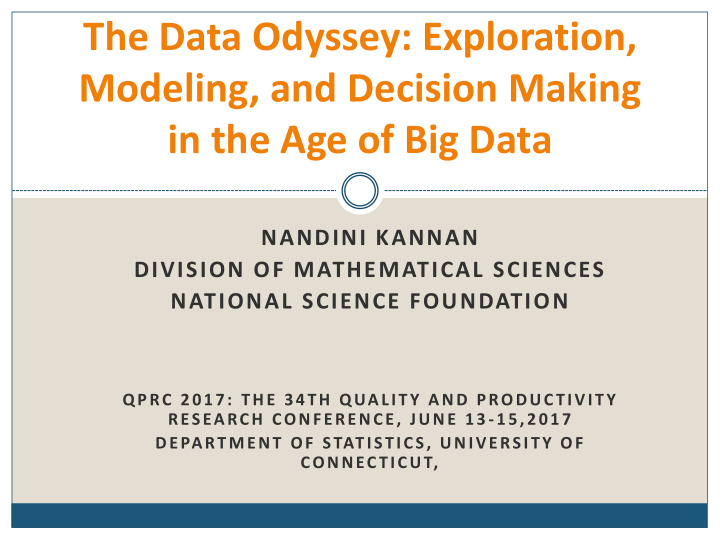



The Data Odyssey: Exploration, Modeling, and Decision Making in the Age of Big Data NANDINI KANNAN DIVISION OF MATHEMATICAL SCIENCES NATIONAL SCIENCE FOUNDATION QPRC 2017: THE 34TH QUALITY AND PRODUCTIVITY RESEARCH CONFERENCE, JUNE 13 -15,2017 DEPARTMENT OF STATISTICS, UNIVERSITY OF CONNECTICUT,
CHALLENGES This is the Age of Data- Big Massive Complex High-Dimensional Humongous Gigantic (Pick your favourite)
DATA “The world of the twenty- first century is a world awash in numbers.” Mathematics and Democracy 2001
It was a Simpler Time Then Now n > 30 -normal Small n, large p- approximations to the Microarray data rescue Large n, Large p Large p (number of And on it goes…. dimensions)-Dimension Tera and Peta and Exa… reduction techniques Kilobytes and Megabytes
What is Big Data? The three V’s: Volume, Velocity, Variety Add to that Variability Veracity
10 Big Ideas for Future NSF Investments bold questions that will drive NSF's long-term research agenda -- questions that will ensure future generations continue to reap the benefits of fundamental S&E research catalyze interest and investment in fundamental research, which is the basis for discovery, invention and innovation set of cutting-edge research agendas….. that will require collaborations with industry, private foundations, other agencies, science academies and societies, and universities. push forward the frontiers of U.S. research and provide innovative approaches to solve some of the most pressing problems the world faces, as well as lead to discoveries not yet known.
Harnessing Data for 21st Century Science and Engineering support basic research in math, statistics and computer science that will enable data-driven discovery through visualization, better data mining, machine learning and more. It will support an open cyberinfrastructure for researchers and develop innovative educational pathways to train the next generation of data scientists
FROM GENOTYPES TO PHENOTYPES Access HYPOTHESIS: Visualization Bigger root systems => Analytics Data Quality better water use and grain yield High Performance Computing Collaboration Tools Models/Methods Exploratory Analysis Digital Imaging of Root Traits DATA: DISCOVERY: Genome Sequences Some root features Trait Measurements affect yield under Environmental Data drought. Experiments Interpretation Data Collection Model Validation THEORY: Benchmark Data Sets Redesign Root variables influence yield, but … How…? What if…?
ASTRONOMY AND BIG DATA Large Synoptic Survey Telescope (LSST) project: 10-year survey of the sky that will deliver a 200 petabyte set of images and data products that will address some of the most pressing questions about the structure and evolution of the universe and the objects in it. Understanding the Mysterious Dark Matter and Dark Energy Hazardous Asteroids and the Remote Solar System The Transient Optical Sky The Formation and Structure of the Milky Way ..3.2 gigapixel camera obtaining images every 30 seconds, the data rate will be about 20 terabytes (equivalent to the entire Congressional Library) per night . Not only that this is a huge data rate, but the data have to be processed and disseminated in real time , and with exquisite accuracy.”
Computer Vision for Microstructural Images Elizabeth A. Holm ( CMU ), DMR-Award #1307138 Microstructural images are the 1. Extract visual features foundational data of materials science. using computer vision methods We use computer vision concepts to extract a unique visual fingerprint for each microstructural image, enabling: • a visual search engine for micrographs • classification of microstructures into groups by material system or structure 2. Obtain a dictionary of • quantification of microstructural metrics keypoint features using cluster analysis without segmentation or measurement • automatic identification of regions of interest The results offer a new way to extract knowledge from microstructural images 3. Create the in order to design new materials, microstructural optimize material processes, and tailor fingerprint material properties. DeCost, B. L.; Holm, E. A., A computer vision approach for automated analysis and classification of microstructural image data. Computational Materials Science 2015, 110, 126-133.
DATA, DATA EVERYWHERE… Smartphones/Apps (Fitbit, Jawbone): tracking fitness, calories, sleep (Streaming Data) Twitter/Facebook Smart Connected Cities: Urban Planning Education Analytics: Personalized Instruction/Learning Internet of Things Marketing, Insurance, Loans
Big Data is driving New areas of research in the mathematical, statistical, and computational sciences (Topological Data Analysis, Natural Language Processing, Deep Learning) Research related to privacy, fairness, reproducibility (Fairness Through Awareness, Cynthia Dwork et al.) Inter-disciplinary and collaborative Research Changes to the curriculum in Computer Science, Mathematics, Statistics Training of undergraduate and graduate students
Why Statistics? “ I keep saying the sexy job in the next ten years will be statisticians. People think I'm joking, but who would've guessed that computer engineers would've been the sexy job of the 1990s?” Hal Varian, Google’s Chief Economist January 2009
The tools of our profession Exploratory Data Analysis Regression-Linear, Nonlinear, Nonparametric… Experimental Design- Sequential Designs, Response Surface Time Series-Nonstationary, Nonlinear Survival Analysis Categorical Data Analysis Nonparametric
New Challenges-New Tools/Skills Data Wrangling Communication-Many of the challenges will require teams of researchers Ethics, Privacy
What makes you significant? Statistics is more than a collection of tools It is a way to think and reason-an art and a science Requires a deep understanding of the data, knowing model assumptions, and the ability to interpret.
Opportunities! Applications are now driving the need for new statistical and computational tools Statisticians get to play in everybody else’s sandbox.
Recommend
More recommend